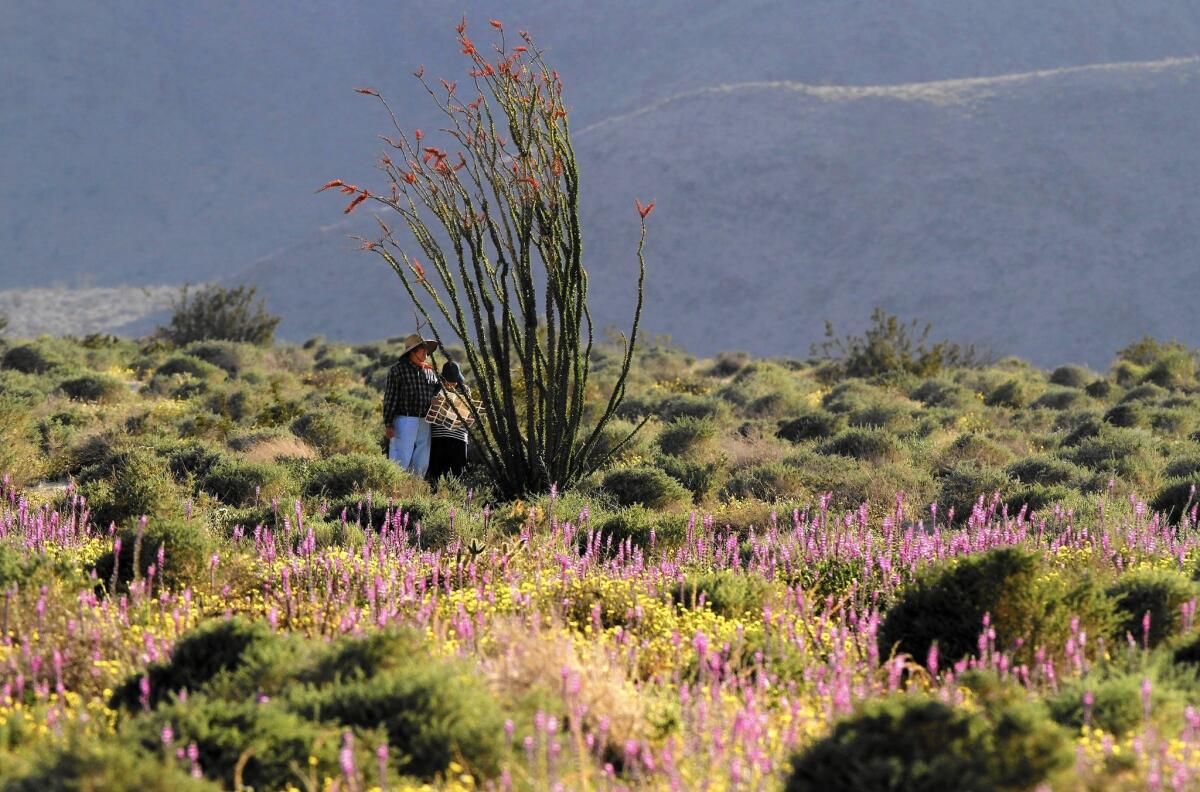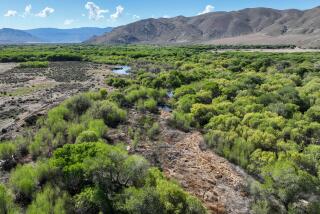The situation is dire as Borrego Water District’s aquifer is being rapidly depleted

Reporting from BORREGO SPRINGS, Calif. — A study recently completed by the U.S. Geological Survey confirms what people in this tiny desert town have suspected for some time: Their only source of water, deep underground, is being depleted roughly four times faster than it is being replenished.
The six-year study, done in conjunction with the Borrego Water District, puts hard numbers to a dire situation. Complicating matters further, the Borrego Water District recently was forced to enter into an agreement with the state saying it will find a way to stop over-drawing the aquifer within 20 years.
“We have no choice,” said Borrego Water District General Manager Jerry Rowling. “If we don’t, the state is going to come in and do it for us. That’s what scares everybody.”
Join the conversation on Facebook >>
The study involved hundreds of groundwater level tests throughout the basin and the examination of records dating back 60 years, to a time when virtually nobody lived in the desert. The town — about 85 miles northeast of San Diego and completely surrounded by Anza-Borrego Desert State Park — is now home to about 3,500 residents.
Golf courses play into the leisure lifestyle and tourist appeal that many believe is key to Borrego Springs’ future, but keeping the fairways green is a formidable challenge in a town where there’s not enough water to go around.
On average, roughly 5,600 acre-feet of water sinks into the aquifer each year from rainfall and other sources, replenishing the relatively small series of underground basins that stretch from north of Borrego Springs southeasterly into eastern Imperial County.
That doesn’t come close to the roughly 20,000 acre-feet of water that has been pumped out of the ground each year for at least two decades. An acre-foot is defined as the volume of one acre of surface area to a depth of one foot. One acre-foot equals about 326,000 gallons.
“Water levels are dropping about 2 feet per year over the past 20 years,” said Claudia Faunt, a Geological Survey supervisory hydrologist and program chief. “Groundwater is the only source of water in Borrego. The annual pumping far exceeds the natural resource, on average.”
The result is that wells are drying up, and in some cases are being deepened to access the water. In certain parts of the basin, the water level has declined more than 100 feet, Faunt said.
The deeper the pumps go, the worse the water becomes, and the more electricity it takes to get it out of the ground, Faunt said. Older water contains sediment. It’s saltier and contains compounds such as arsenic.
The study also confirmed where the water is going: about 70% is being used for agriculture, 20% for recreation (primarily golf courses) and 10% for residential use.
The obvious solution is to get rid of agriculture in the valley, but to do so could cause severe damage to the town’s economy. The study includes various computer simulations that can be applied to multiple groundwater-management scenarios as far as 50 years in the future.
The study and models will help Borrego Valley water managers meet requirements put in place by the new California Sustainable Groundwater Management Act signed by Gov. Jerry Brown in 2014. They have 20 years to make it happen.
Agriculture is by necessity going to be front and center of any future plans.
The study found there are about 2,000 acres of citrus trees in the northern Borrego Valley that consume about 43% of all the groundwater pumped out of the aquifer system. Palm tree farms and ornamental shrubbery nurseries make up much of the rest of the agricultural product.
Jim Seley, whose family has grown citrus in the valley since the 1950s, said the survey results are alarming. He said his 370-acre grapefruit, lemon and tangerine ranch has been trying to conserve water ever since the 1960s when the first drip irrigation system at a desert farm was installed.
Over the years, all sorts of other measures have been taken to prevent over-watering, Seley said, and the farm is now experimenting with planting fewer trees but ones they hope will yield more fruit.
“We constantly are changing to become more efficient,” he said.
Looking ahead 20 years, Seley said he imagines a 70% reduction of agriculture in the valley with many of the farmers giving up, partly because the cost of the electricity to pump water will become prohibitive.
Water and Power is The Times’ guide to the drought. Sign up to get the free newsletter >>
“I think you’ll still have smaller farms, but not as many,” he said, noting that will affect the economy of the town. Agriculture in the valley employs hundreds of people at harvest time and probably about 100 year-round — people who often shop in the small community and who send their kids to the local schools.
“It impacts everything,” he said.
For the last four years, a group called the Borrego Water Coalition, which brings together water users from all over the valley, has been meeting monthly to discuss and plan for the future.
“We need to create a sustainability plan,” Rowling said. “We need to figure out what has to happen. We’re just at the very beginning of that. We want to make sure everybody in the community has a say in this, because we’re the ones who have to deal with this. This is our valley. This is our groundwater basin.”
Twitter: @jharryjones
ALSO
2015 was the hottest year on record, according to new data
California to investigate whether Exxon Mobil lied about climate-change risks
Is the best use of El Niño water to pour it out on dry soil? UC Davis researchers try it out.
More to Read
Sign up for Essential California
The most important California stories and recommendations in your inbox every morning.
You may occasionally receive promotional content from the Los Angeles Times.










